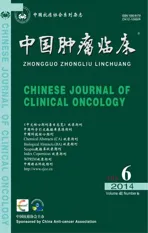mTOR抑制剂在乳腺癌内分泌治疗耐药中的研究进展*
2014-01-24综述审校
刘 艳 综述 张 瑾 审校
mTOR抑制剂在乳腺癌内分泌治疗耐药中的研究进展*
刘 艳 综述 张 瑾 审校
PI3K/Akt/mTOR信号转导通路可抑制肿瘤细胞凋亡、促进细胞生存、调节细胞周期,促进肿瘤新生血管的形成以及侵袭与转移,在肿瘤的发生、发展、治疗及转归中发挥着重要作用。该信号通路与乳腺癌关系非常密切,是乳腺癌新的治疗靶点及研究热点。mTOR抑制剂通过不同的靶点作用于PI3K/Akt/mTOR信号转导通路上,从而达到其抗癌作用。内分泌治疗是乳腺癌的重要治疗方式之一,与化疗等其他治疗方式一样,内分泌治疗同样也面临治疗耐受这一难题。随着越来越多的信号通路被揭示,单一阻断某一位点已经不能满足治疗的需要,寻找多条通路的共同抑制位点成为研究人员关注的焦点。本文就mTOR抑制剂在乳腺癌内分泌治疗耐药中的作用及其临床试验结果进行综述,以期进一步了解mTOR抑制剂的临床作用。
乳腺癌 耐药 mTOR抑制剂 内分泌治疗
The 3rd Department of Breast Cancer,Tianjin Center for Breast Cancer Prevention,Treatment and Research,Tianjin Medical Uni
versity Cancer Institute and Hospital,National Clinical Research Center of Cancer,Key Laboratory of Breast Cancer Prevention
and Therapy,Tianjin Medical University,Ministry of Education,Tianjin 300060,China
This work was supported by the Special Fund of major scientific projects forAnti-cancer Research(No.12ZCDZSY15400)
乳腺癌是全身激素依赖性疾病,内分泌治疗是乳腺癌综合治疗的重要手段之一,该治疗的最大问题是原发性、继发性耐药,其确切机制尚不明确。现已证实内分泌治疗耐药与信号转导有关[1],寻找多条信号转导通路的共同抑制位点成为研究焦点。恶性肿瘤治疗的目标在于根据不同分子分型进行针对性靶向治疗,即为患者提供个体化的信号转导抑制剂(signal transduction inhibitor,STI)治疗。PI3K/Akt/ mTOR信号转导通路作为细胞内重要信号转导通路之一,通过影响下游多种效应分子的活化状态,在细胞内发挥抑制凋亡、促进增殖的关键作用,并与乳腺癌的发生发展密切相关。本文对该通路的组成、功能及其抗肿瘤作用的应用等方面的研究进展进行综述,为寻找通路中作为乳腺癌治疗靶点的关键分子提供参考。
1 乳腺癌内分泌治疗耐药
乳腺癌内分泌治疗可通过抑制雌激素信号通路来实现[1]。芳香化酶抑制剂(AIs)是激素受体阳性绝经后乳腺癌的标准一线药物[2]。但很多患者对AIs存在原发或获得性耐药[3],且发生转移者更换AIs并未有效抑制病情进展[4]。AIs耐药有多种机制,包括ER本身功能发生变化,或与雌激素信号通路存在交叉或互补的信号通路,为肿瘤细胞提供逃逸途径等。研究表明,服用他莫昔芬或AIs的患者MAPK、PI3K/ Akt通路异常活化,mTOR、HER-2等蛋白表达增加[5]而MAPK和Akt能直接激活ER[1]。由此可见PI3K/ Akt/mTOR信号通路可能是导致内分泌治疗耐受的关键因素[6-7]。
2 mTOR与乳腺癌
mTOR是丝氨酸/苏氨酸激酶,通过PI3K/Akt和AMPK通路实现对生长和代谢的调控[8-10]。在AMPK通路中,mTOR能调控下游高耗能的细胞活动及自噬。在PI3K/Akt通路中,mTOR是调节细胞生长和增殖的关键因子。mTOR抑制剂能降低多种癌细胞系增殖能力,并能与其他信号通路的抑制剂协同作用或改善患者对某些抑制剂的耐药性。西罗莫司酯化物是注射型mTOR抑制剂,已被批准用于肾细胞癌治疗中。依维莫司是口服型mTOR抑制剂,主要用于胰腺起源的神经内分泌癌和晚期肾细胞癌等。雷帕霉素可用于预防肾移植后的器官排斥反应。
3 mTOR抑制剂与乳腺癌
3.1 mTOR抑制剂在乳腺癌治疗中的应用
研究显示高表达Akt的MCF-7乳腺癌细胞在缺乏雌激素状态下仍可增殖且对他莫昔芬耐受[11],而mTOR抑制剂西罗莫司酯化物可恢复他莫昔芬的敏感性。体外和体内研究均证实依维莫司可逆转来曲唑耐药[12-13]。研究人员还发现依维莫司可恢复乳腺癌细胞对氟维司群的敏感性[13]。
目前已开展HR(+)晚期乳腺癌患者应用西罗莫司酯化物或依维莫司的临床试验。在一项未接受过AIs治疗患者应用mTOR抑制剂西罗莫司酯化物联合来曲唑治疗疗效的Ⅲ期临床试验中,选取HR(+)晚期乳腺癌患者1 112例,口服来曲唑2.5 mg/d联合西罗莫司酯化物30 mg/d(5 d/2周)与来曲唑+安慰剂的疗效比较。结果显示两组PFS、CR和PR无明显差异,其中两组PFS均为9个月(HR=0.90,95%CI∶0.76~1.07,P=0.25),在接受过辅助内分泌治疗的患者中,来曲唑联合西罗莫司酯化物组亦无显著PFS获益[14]。提示该药物与来曲唑联合应用未能使晚期乳腺癌患者获益,难以达到临床治疗需求。在TAMRAD试验中依维莫司却显示出与内分泌药物联合使用的明显优势。该试验是针对111例AIs治疗失败的HR(+)绝经后转移性乳腺癌患者的Ⅱ期临床试验,比较他莫昔芬联合依维莫司和单药他莫昔芬治疗疗效的差异。结果显示联合治疗组在临床获益率(61.1% vs.42.1%)及PFS(8.5个月vs.4.5个月)均明显优于单药治疗组,且对PFS的分层分析表明联合治疗组改善继发耐药效果更为显著(77.8%vs.44.8%)[15]。
BOLERO-2试验是依维莫司Ⅲ期临床试验[14]。选取使用来曲唑或阿那曲唑出现进展或复发的HR(+)晚期乳腺癌患者,随机分配到依维莫司联合依西美坦组、空白对照组或依西美坦单药组。结果显示联合治疗组PFS明显延长且临床有效率和客观反应率较高。治疗6和12周后检验骨代谢相关标记物如碱性磷酸酶、Ⅰ型胶原蛋白N端肽等。结果显示联合治疗组标记物含量减低,提示依维莫司可能阻断或逆转依西美坦所致的溶骨作用。但西罗莫司酯化物联合来曲唑的临床试验并未取得预期效果,而依维莫司联合依西美坦无论是PFS还是对骨的保护作用都显示了优势。这些差异可能与研究对象的选取、药物剂量及药代动力学有一定关系。
3.2 mTOR抑制剂的不良反应
mTOR抑制剂的不良反应包括口腔炎、非传染性肺炎、高血糖、感染增加等[14,16-18]。mTOR抑制剂联合其他药物治疗的HR(+)乳腺癌患者中约56%出现口腔炎[16],3级或4级口腔炎发生率为3%~11%,而对照组中无1例出现[14,16-18]。用药前对患者不良反应的告知十分必要。早期干预可减轻患者的不良反应,同时减少辣、酸、咸食物的过度摄入也有益处。症状轻微时可选用不含酒精的漱口水或0.9%盐水,症状较严重时须加服镇痛药或激素,必要时要减低药量或停药,症状更为严重时必须马上停药,必要时还需添加抗病毒或抗真菌药物[19]。mTOR参与血糖调控,因此高血糖是mTOR抑制剂常见不良反应之一[14,16-18,20],3度或4度高血糖发生率约为4%[16]。患者选用mTOR抑制剂时应注意监测血糖,必要时给予适度干预。糖尿病患者更应严格控制血糖[20]。非炎性和非肿瘤性肺炎也是mTOR抑制剂常见不良反应之一,约2% HR(+)乳腺癌患者接受依维莫司联合来曲唑新辅助治疗后出现3级或者以上的肺炎,但来曲唑单药组或空白对照组中无1例出现[21]。晚期乳腺癌患者接受依维莫司联合依西美坦治疗,约3%出现3级肺炎[16]。因此加强监测、早期诊断、有效干预是十分必要的[19]。
3.3 相关临床试验
依维莫司联合曲妥珠单抗的Ⅲ期临床试验正在进行中。研究对象为曲妥珠单抗耐药并行含紫杉类药物化疗的局部进展或转移的HER-2(+)乳腺癌患者[22]。除依维莫司之外,也将有更多针对内分泌耐药的靶向药物进入临床试验阶段。L147为选择性的可逆PI3K抑制剂,作用于p110α时IC50为40 nM。XL147抑制PI3K亚型,为ATP竞争性抑制剂。在HER-2过表达的人类乳腺癌细胞系中,使用XL147处理抑制Akt和核糖体蛋白S6激酶的磷酸化,诱导HER-3和其他RTK的表达和磷酸化作用[23]。其他靶向药物如BKM120(泛PI3K抑制剂)、BYL719(选择性α-PI3K抑制剂)和BEZ235(泛PI3K及TORC1/2抑制剂)等,可能为后续内分泌耐药的临床治疗提供更多参考,但相关结果有待更大规模临床数据的支持。
4 展望
综上所述,mTOR抑制剂在晚期乳腺癌患者治疗中具有重要作用,但鉴于Akt旁路活化等伴随现象的存在,对PI3K和mTOR的双重抑制剂的基础和临床研究还需进一步深入,使其更好地改善患者预后。
1 Chumsri S,Howes T,Bao T,et al.Aromatase,aromatase inhibitors, and breast cancer[J].J Steroid Biochem Mol Biol,2011,125(1-2): 13-22.
2 Mouridsen H,Gershanovich M,Sun Y,et al.Phase III study of letrozole versus tamoxifen as first-line therapy of advanced breast cancer in postmenopausal women:analysis of survival and update of efficacy from the International Letrozole Breast Cancer Group[J]. J Clin Oncol,2003,21(11):2101-2109.
3 Massarweh S,Schiff R.Resistance to endocrine therapy in breast cancer:exploiting estrogen receptor/growth factor signaling crosstalk[J].Endocr Relat Cancer,2006,13(Suppl 1):S15-24.
4 Bachelot T,Bourgier C,Cropet C,et al.Randomized phase II trial of everolimus in combination with tamoxifen in patients with hormone receptor-positive,human epidermal growth factor receptor 2-negative metastatic breast cancer with prior exposure to aromatase inhibitors: a GINECO study[J].J Clin Oncol,2012,30(22):2718-2724.
5 Jelovac D,Sabnis G,Long BJ,et al.Activation of mitogen-activated protein kinase in xenografts and cells during prolonged treatment with aromatase inhibitor letrozole[J].Cancer Res,2005,65 (12):5380-5389.
6 Miller TW,Hennessy BT,González-Angulo AM,et al.Hyperactivation of phosphatidylinositol-3 kinase promotes escape from hormone dependence in estrogen receptor-positive human breast cancer[J].J Clin Invest,2010,120(7):2406-2413.
7 Yue W,Fan P,Wang J,et al.Mechanisms of acquired resistance to endocrine therapy in hormone-dependent breast cancer cells[J].J Steroid Biochem Mol Biol,2007,106(1-5):102-110.
8 Dobashi Y,Watanabe Y,Miwa C,et al.Mammalian target of rapamycin:a central node of complex signaling cascades[J].Int J Clin Exp Pathol,2011,4(5):476-495.
9 Wullschleger S,Loewith R,Hall MN.TOR signaling in growth and metabolism[J].Cell,2006,124(3):471-484.
10 Alers S,Löffler AS,Wesselborg S,et al.Role of AMPK-mTOR-Ulk1/ 2 in the regulation of autophagy:cross talk,shortcuts,and feedbacks [J].Mol Cell Biol,2012,32(1):2-11.
11 deGraffenried LA,Friedrichs WE,Russell DH,et al.Inhibition of mTOR activity restores tamoxifen response in breast cancer cells with aberrant Akt Activity[J].Clin Cancer Res,2004,10(23):8059-8067.
12 Boulay A,Rudloff J,Ye J,et al.Dual inhibition of mTOR and estrogen receptor signaling in vitro induces cell death in models of breast cancer[J].Clin Cancer Res,2005,11(14):5319-5328.
13 Beeram M,Tan QT,Tekmal RR,et al.Akt-induced endocrine therapy resistance is reversed by inhibition of mTOR signaling[J]. Ann Oncol,2007,18(8):1323-1328.
14 Alexander W.San antonio breast cancer symposium[J].PT,2011,36 (3):156-158.
15 Bachelot T,Bourgier C,Cropet C,et al.Randomized phase II trial of everolimus in combination with tamoxifen in patients with hormone receptor-positive,human epidermal growth factor receptor 2-negative metastatic breast cancer with prior exposure to aromatase inhibitors: a GINECO study[J].J Clin Oncol,2012,30(22):2718-2724.
16 Baselga J,Campone M,Piccart M,et al.Everolimus in postmenopausal hormone-receptor-positive advanced breast cancer[J].N Engl J Med,2012,366(6):520-529.
17 Yardley DA,Noguchi S,Pritchard KI,et al.Everolimus plus exemestane in postmenopausal patients with HR(+)breast cancer: BOLERO-2 final progression-free survival analysis[J].Adv Ther, 2013,30(10):870-884.
18 Gomez-Fernandez C,Garden BC,Wu S,et al.The risk of skin rash and stomatitis with the mammalian target of rapamycin inhibitor temsirolimus:a systematic review of the literature and meta-analysis[J].Eur J Cancer,2012,48(3):340-346.
19 Porta C,Osanto S,Ravaud A,et al.Management of adverse events associated with the use of everolimus in patients with advanced renal cell carcinoma[J].Eur J Cancer,2011,47(9):1287-1298.
20 Eisen T,Sternberg CN,Robert C,et al.Targeted therapies for renal cell carcinoma:review of adverse event management strategies [J].J Natl Cancer Inst,2012,104(2):93-113.
21 Baselga J,Semiglazov V,van Dam P,et al.Phase II randomized study of neoadjuvant everolimus plus letrozole compared with placebo plus letrozole in patients with estrogen receptor-positive breast cancer[J].J Clin Oncol,2009,27(16):2630-2637.
22 Sendur MA,Zengin N,Aksoy S,et al.Everolimus:a new hope for patients with breast cancer[J].Curr Med Res Opin,2014,30(1):75-87.
23 Martina JA,Chen Y,Gucek M,et al.MTORC1 functions as a transcriptional regulator of autophagy by preventing nuclear transport of TFEB[J].Autophagy,2012,8(6):903-914.
(2013-11-15收稿)
(2014-01-21修回)
(本文编辑∶张刡)
Development of mTOR inhibitor in endocrine therapy-resistant breast cancer
Yan LIU,Jin ZHANG
Correspondence to:Zhang JIN;E-mail:zhangjin@tjmuch.com
The PI3K/Akt/mTOR signaling pathway is involved in inhibiting the apoptosis of tumor cells,promoting cell survival, and regulating cell cycle,as well as in the angiogenesis,invasion,and metastasis of tumors.Therefore,this pathway has an important function in tumorigenesis,tumor growth,prognosis,and treatment.So the PI3K/Akt/mTOR signaling pathway as a new therapeutic target and has been highlighted in breast cancer research.Pre-clinical studies have confirmed that mTOR inhibitors achieve anticancer effects by targeting the PI3K/Akt/mTOR signaling pathway.Endocrine therapy is the primary method in breast cancer treatment.However,this therapy has instances of drug resistance because chemotherapy and other treatments are administered to patients.Only blocking one site point does not meet the treatment needs because more signaling pathways have been identified.Identifying a common inhibitory site for multiple pathways has become the focus of research.The mTOR inhibitor is the crossing point of multiple signaling pathways and has attracted extensive attention in this subject.
breast cancer,drug resistance,mTOR inhibitor,endocrine therapy
10.3969/j.issn.1000-8179.20131923
刘艳 硕士,主治医师,研究方向为乳腺肿瘤学。
天津医科大学肿瘤医院乳腺三科,国家肿瘤临床医学研究中心,乳腺癌防治教育部重点实验室(天津市300060)
*本文课题受天津市重大科技专项(工程)项目抗癌重大科技专项(编号:12ZCDZSY15400)资助
张瑾 zhangjin@tijmuch.com
日期:2014-2-10 网络出版地址:http://www.cnki.net/kcms/doi/10.3969/j.issn.1000-8179.20131923.html
E-mail∶elvasangwoo@hotmail.com
